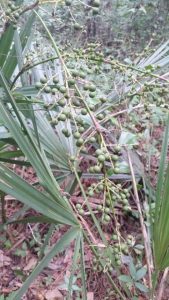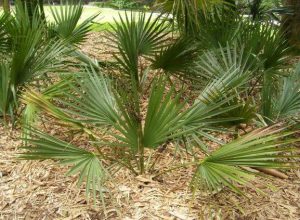
The Dwarf Palmetto (Sabal minor) is a native palm which can grow in North-, Central-, and South- Florida. It is also known as Blue-Stem Palmetto due to its blueish-green fronds. As with other palms in the Sabal genus, the Dwarf Palmetto provides a nectar and food source for pollinators and birds respectively.
Planting Site
The Scrub Palmetto does best in partial shade, typically growing as an understory plant in its natural habitat. It is highly salt tolerant and prefers moist soil. With a spreading growth habit, at maturity, Dwarf Palmettos grow can be 4 to 9 ft. tall by 4 to 8 ft. wide.
Nutrient requirements
Dwarf Palmettos typically do not experience significant nutrient deficiencies in the landscape. Should nutrient deficiencies occur (e.g. yellowing fronds or yellow/brown spots on fronds), a soil pH reading should be taken prior to applying a fertilizer specially formulated for palms. For more information on fertilizing palms, click on this link fertilizing palms.
 Pests and diseases
Pests and diseases
Although Dwarf Palmettos usually do not experience significant pest and disease issues in the landscape, regular scouting for signs of pests/diseases is recommended to support optimal plant health.
Learn more:
For more information on the Dwarf Palmetto, click on this link.
Source: UF/IFAS Pest Alert
Note: All images and contents are the property of UF/IFAS.



